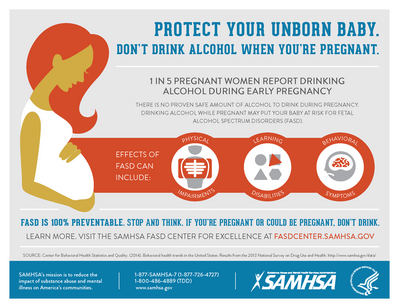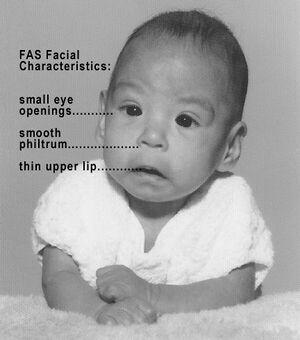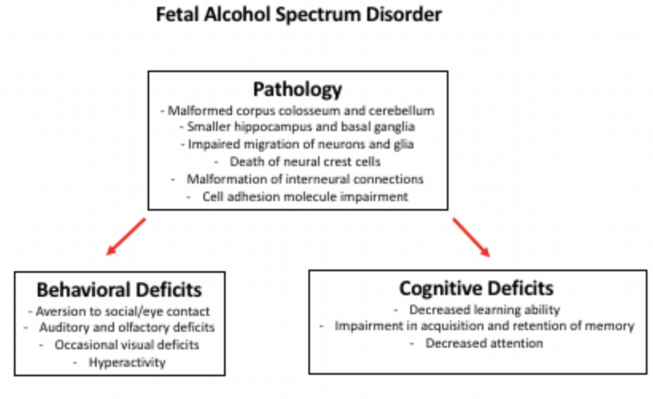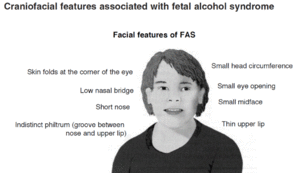Fetal Alcohol Spectrum Disorder (FASD): Difference between revisions
No edit summary |
No edit summary |
||
| Line 6: | Line 6: | ||
== Introduction == | == Introduction == | ||
[[File:Fetal Alcohol Spectrum Disorders (FASD) in the United States (22185062444).png|right|frameless|399x399px]] | [[File:Fetal Alcohol Spectrum Disorders (FASD) in the United States (22185062444).png|right|frameless|399x399px]] | ||
Fetal alcohol spectrum disorder (FASD) refers to a range of problems caused by exposure of a fetus to alcohol during pregnancy. FASD | Fetal alcohol spectrum disorder (FASD) refers to a range of problems caused by exposure of a fetus to alcohol during pregnancy. FASD is the most common preventable cause of developmental disability.<ref>The Conversation [https://theconversation.com/the-truth-about-fetal-alcohol-spectrum-disorder-103240 The truth about fetal alcohol spectrum disorder] Available: https://theconversation.com/the-truth-about-fetal-alcohol-spectrum-disorder-103240 (last accessed 16.10.2021)</ref> | ||
* There is no cure for FASD and its effects last a lifetime. eg behavioural, intellectual, neurological and mental health difficulties. | * FASD affects children and youth across all races, ethnicities, cultures and socioeconomic status. | ||
* There is no cure for FASD and its effects last a lifetime. eg behavioural, intellectual, [[Neurological Disorders|neurological]] and mental health difficulties. | |||
* A person with FASD can get help with their learning and behaviour to maximise their independence and achievements. | * A person with FASD can get help with their learning and behaviour to maximise their independence and achievements. | ||
* Not drinking alcohol during pregnancy is the safest option<ref name=":0">Better Health [https://www.betterhealth.vic.gov.au/health/conditionsandtreatments/fetal-alcohol-spectrum-disorder-fasd#bhc-content FASD] Available: https://www.betterhealth.vic.gov.au/health/conditionsandtreatments/fetal-alcohol-spectrum-disorder-fasd#bhc-content (accessed 16.10.2021)</ref>. | * Not drinking alcohol during pregnancy is the safest option<ref name=":0">Better Health [https://www.betterhealth.vic.gov.au/health/conditionsandtreatments/fetal-alcohol-spectrum-disorder-fasd#bhc-content FASD] Available: https://www.betterhealth.vic.gov.au/health/conditionsandtreatments/fetal-alcohol-spectrum-disorder-fasd#bhc-content (accessed 16.10.2021)</ref>. See also [[Preconceptual care]] | ||
== What is FASD == | == What is FASD == | ||
[[File:Photo of baby with FAS.jpeg|right|frameless]] | |||
Fetal alcohol spectrum disorder (FASD) refers to the range of problems caused by prenatal exposure to alcohol (exposure to alcohol during pregnancy). | Fetal alcohol spectrum disorder (FASD) refers to the range of problems caused by prenatal exposure to alcohol (exposure to alcohol during pregnancy). | ||
If a woman drinks alcohol while she is pregnant, the alcohol crosses the placenta from her blood into the baby’s bloodstream and the baby is exposed to similar concentrations of alcohol as the mother. | If a woman drinks alcohol while she is pregnant, the alcohol crosses the placenta from her [[blood]] into the baby’s bloodstream and the baby is exposed to similar concentrations of alcohol as the mother. Babies severely affected by FASD are at risk of dying before they are born.<ref name=":0" /> | ||
The effects of alcohol on a fetus include: | The effects of alcohol on a fetus include: | ||
* | * Facial/oral: short palpebral fissures; mid facial hypoplasia; long thin upper lip | ||
* | * Cranial/CN: microcephaly; intellectual impairment; [[Corpus Callosum|corpus callosum]] agenesis/ dysgenesis; focal [[Cerebral Cortex|cortical]] thickening | ||
* | * Skeletal: delayed bone development; [[Pectus carinatum ( pigeon chest )|pectus excavatum]]; vertebral segmental anomalies: [[Congenital Spine Deformities|congenital scoliosis]]; limb anomalies; fusion of upper limbs: radio-ulnar synostoses | ||
* Cardiac: [[Congenital Heart Disease|septal defects]]<ref name=":2" /> | |||
Not all babies exposed to alcohol develop FASD. The risk of harm to the fetus is highest when prenatal exposure to alcohol occurs regularly or due to frequent binge drinking.<ref name=":0" /> | Not all babies exposed to alcohol develop FASD. The risk of harm to the fetus is highest when prenatal exposure to alcohol occurs regularly or due to frequent binge drinking.<ref name=":0" /> | ||
== Epidemiology == | == Epidemiology == | ||
Prenatal alcohol exposure is the leading cause of preventable congenital disabilities<ref name=":2">Vorgias D, Bernstein B. [https://www.statpearls.com/articlelibrary/viewarticle/21698/ Fetal Alcohol Syndrome]. StatPearls [Internet]. 2020 Aug 23.Available:https://www.statpearls.com/articlelibrary/viewarticle/21698/ (accessed 16.10.2021)</ref>. The estimated incidence in the western world is at around ~10% for FASD It may affect up to 20-40% of pregnancies in mothers with chronic alcohol abuse.<ref name=":1">Radiopedia [https://radiopaedia.org/articles/fetal-alcohol-syndrome Fetal alcohol syndrome] Available: https://radiopaedia.org/articles/fetal-alcohol-syndrome (accessed 16.10.2021)</ref> | Prenatal alcohol exposure is the leading cause of preventable congenital disabilities<ref name=":2">Vorgias D, Bernstein B. [https://www.statpearls.com/articlelibrary/viewarticle/21698/ Fetal Alcohol Syndrome]. StatPearls [Internet]. 2020 Aug 23.Available:https://www.statpearls.com/articlelibrary/viewarticle/21698/ (accessed 16.10.2021)</ref>. The estimated incidence in the western world is at around ~10% for FASD It may affect up to 20-40% of pregnancies in mothers with [[Alcoholism|chronic alcohol abuse]].<ref name=":1">Radiopedia [https://radiopaedia.org/articles/fetal-alcohol-syndrome Fetal alcohol syndrome] Available: https://radiopaedia.org/articles/fetal-alcohol-syndrome (accessed 16.10.2021)</ref> | ||
In many cases, prenatal alcohol exposure is unintentional because women continue their normal drinking patterns before they know they are pregnant. Most women stop drinking alcohol once made aware of their pregnancy. Despite this fact, 7.6% of women report continued drinking during pregnancy.<ref name=":2" /> | In many cases, prenatal alcohol exposure is unintentional because women continue their normal drinking patterns before they know they are pregnant. Most women stop drinking alcohol once made aware of their pregnancy. Despite this fact, 7.6% of women report continued drinking during pregnancy.<ref name=":2" /> | ||
== Pathophysiology == | == Pathophysiology == | ||
The exact mechanism by which alcohol causes its teratogenic effects is not known. For obvious ethical reasons, formal studies on the effects of alcohol on human brain development are limited. Most of our data come from animal models and associations with alcohol exposure | The exact mechanism by which alcohol causes its teratogenic (causing [[Congenital and Acquired Neuromuscular and Genetic Disorders|congenital]] anomalies or birth defects) effects is not known. For obvious ethical reasons, formal studies on the effects of alcohol on human brain development are limited. Most of our data come from animal models and associations with alcohol exposure. | ||
We also know from associations that: | We do know that alcohol is a teratogen that causes irreversible damage to the [[Introduction to Neuroanatomy|central nervous system]] (CNS). From associations with alcohol exposure, we are aware that that damage is widespread, causing not only a decrease in [[Brain Anatomy|brain]] volume but also damage to structures within the brain. [[File:Fetal ASD.png|frameless|653x653px|alt=|center]]We also know from associations that: | ||
# High levels of alcohol consumption in the first trimester resulted in an increased likelihood of facial and brain anomalies. | # High levels of alcohol consumption in the first trimester resulted in an increased likelihood of [[Facial Skeleton|facial]] and brain anomalies. | ||
# High levels of alcohol consumption in the second trimester are associated with increased incidences of spontaneous abortions. | # High levels of alcohol consumption in the second trimester are associated with increased incidences of spontaneous abortions. | ||
# High levels of alcohol consumption in the third trimester are associated with decreased height, weight, and brain volume. | # High levels of alcohol consumption in the third trimester are associated with decreased height, weight, and brain volume. | ||
| Line 49: | Line 46: | ||
== Management == | == Management == | ||
[[File:FASDkid.gif|right|frameless]] | |||
CNS damage from prenatal alcohol exposure is permanent, there is no cure for fetal alcohol spectrum disorders. However, treatment to mitigate the effects of fetal alcohol spectrum disorders is available. Given the extensive variation in presentation and damage that prenatal exposure to alcohol can cause, treatment for fetal alcohol spectrum disorders is often tailored and specific to individuals. | CNS damage from prenatal alcohol exposure is permanent, there is no cure for fetal alcohol spectrum disorders. However, treatment to mitigate the effects of fetal alcohol spectrum disorders is available. Given the extensive variation in presentation and damage that prenatal exposure to alcohol can cause, treatment for fetal alcohol spectrum disorders is often tailored and specific to individuals. | ||
| Line 57: | Line 55: | ||
Although there are many consequences of FASD, the focus for physical therapy is the neuromotor abnormalities associated with F AS, that may require consultation or intervention. | Although there are many consequences of FASD, the focus for physical therapy is the neuromotor abnormalities associated with F AS, that may require consultation or intervention. | ||
There are | There are two elements in the management of FASD. | ||
# An appropriate treatment program that addresses specific symptoms must/be designed. | # An appropriate treatment program that addresses specific symptoms must/be designed. | ||
# The treatment program and outcomes with respect to the child with FAS must be monitored carefully. Treatment programs for children with FAS should address impairments with intellectual, behavior, and social | # The treatment program and outcomes with respect to the child with FAS must be monitored carefully. | ||
Treatment programs for children with FAS should address impairments with intellectual, behavior, and social functioning , as well as deficits<ref>Emerson ML. Fetal alcohol syndrome: physical therapy implications and treatment strategies. Available:https://commons.und.edu/pt-grad/128/ (accessed 16.10.2021)</ref>See [[Motor Control and Learning]] | |||
== Resources == | == Resources == | ||
Revision as of 06:19, 16 October 2021
Original Editor - Lucinda hampton
Top Contributors - Lucinda hampton, Kirenga Bamurange Liliane and Kim Jackson
Introduction[edit | edit source]
Fetal alcohol spectrum disorder (FASD) refers to a range of problems caused by exposure of a fetus to alcohol during pregnancy. FASD is the most common preventable cause of developmental disability.[1]
- FASD affects children and youth across all races, ethnicities, cultures and socioeconomic status.
- There is no cure for FASD and its effects last a lifetime. eg behavioural, intellectual, neurological and mental health difficulties.
- A person with FASD can get help with their learning and behaviour to maximise their independence and achievements.
- Not drinking alcohol during pregnancy is the safest option[2]. See also Preconceptual care
What is FASD[edit | edit source]
Fetal alcohol spectrum disorder (FASD) refers to the range of problems caused by prenatal exposure to alcohol (exposure to alcohol during pregnancy).
If a woman drinks alcohol while she is pregnant, the alcohol crosses the placenta from her blood into the baby’s bloodstream and the baby is exposed to similar concentrations of alcohol as the mother. Babies severely affected by FASD are at risk of dying before they are born.[2]
The effects of alcohol on a fetus include:
- Facial/oral: short palpebral fissures; mid facial hypoplasia; long thin upper lip
- Cranial/CN: microcephaly; intellectual impairment; corpus callosum agenesis/ dysgenesis; focal cortical thickening
- Skeletal: delayed bone development; pectus excavatum; vertebral segmental anomalies: congenital scoliosis; limb anomalies; fusion of upper limbs: radio-ulnar synostoses
- Cardiac: septal defects[3]
Not all babies exposed to alcohol develop FASD. The risk of harm to the fetus is highest when prenatal exposure to alcohol occurs regularly or due to frequent binge drinking.[2]
Epidemiology[edit | edit source]
Prenatal alcohol exposure is the leading cause of preventable congenital disabilities[3]. The estimated incidence in the western world is at around ~10% for FASD It may affect up to 20-40% of pregnancies in mothers with chronic alcohol abuse.[4]
In many cases, prenatal alcohol exposure is unintentional because women continue their normal drinking patterns before they know they are pregnant. Most women stop drinking alcohol once made aware of their pregnancy. Despite this fact, 7.6% of women report continued drinking during pregnancy.[3]
Pathophysiology[edit | edit source]
The exact mechanism by which alcohol causes its teratogenic (causing congenital anomalies or birth defects) effects is not known. For obvious ethical reasons, formal studies on the effects of alcohol on human brain development are limited. Most of our data come from animal models and associations with alcohol exposure.
We do know that alcohol is a teratogen that causes irreversible damage to the central nervous system (CNS). From associations with alcohol exposure, we are aware that that damage is widespread, causing not only a decrease in brain volume but also damage to structures within the brain.
We also know from associations that:
- High levels of alcohol consumption in the first trimester resulted in an increased likelihood of facial and brain anomalies.
- High levels of alcohol consumption in the second trimester are associated with increased incidences of spontaneous abortions.
- High levels of alcohol consumption in the third trimester are associated with decreased height, weight, and brain volume.
Associations with alcohol exposure show that the neurobehavioral deficits associated with fetal alcohol spectrum disorders can occur within a wide range of exposure to alcohol and at any point in the pregnancy[3].
Management[edit | edit source]
CNS damage from prenatal alcohol exposure is permanent, there is no cure for fetal alcohol spectrum disorders. However, treatment to mitigate the effects of fetal alcohol spectrum disorders is available. Given the extensive variation in presentation and damage that prenatal exposure to alcohol can cause, treatment for fetal alcohol spectrum disorders is often tailored and specific to individuals.
- One of the most common treatment approaches is using the medical home to coordinate developmental and educational resources.
- Treatment methodology seeks to tailor specific therapies to reinforce and address any delays or deficiencies with additional education, practice, and reminders[3].
Physiotherapy[edit | edit source]
Although there are many consequences of FASD, the focus for physical therapy is the neuromotor abnormalities associated with F AS, that may require consultation or intervention.
There are two elements in the management of FASD.
- An appropriate treatment program that addresses specific symptoms must/be designed.
- The treatment program and outcomes with respect to the child with FAS must be monitored carefully.
Treatment programs for children with FAS should address impairments with intellectual, behavior, and social functioning , as well as deficits[5]See Motor Control and Learning
Resources[edit | edit source]
- bulleted list
- x
or
- numbered list
- x
References[edit | edit source]
- ↑ The Conversation The truth about fetal alcohol spectrum disorder Available: https://theconversation.com/the-truth-about-fetal-alcohol-spectrum-disorder-103240 (last accessed 16.10.2021)
- ↑ 2.0 2.1 2.2 Better Health FASD Available: https://www.betterhealth.vic.gov.au/health/conditionsandtreatments/fetal-alcohol-spectrum-disorder-fasd#bhc-content (accessed 16.10.2021)
- ↑ 3.0 3.1 3.2 3.3 3.4 Vorgias D, Bernstein B. Fetal Alcohol Syndrome. StatPearls [Internet]. 2020 Aug 23.Available:https://www.statpearls.com/articlelibrary/viewarticle/21698/ (accessed 16.10.2021)
- ↑ Radiopedia Fetal alcohol syndrome Available: https://radiopaedia.org/articles/fetal-alcohol-syndrome (accessed 16.10.2021)
- ↑ Emerson ML. Fetal alcohol syndrome: physical therapy implications and treatment strategies. Available:https://commons.und.edu/pt-grad/128/ (accessed 16.10.2021)










